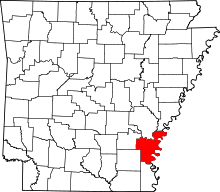Napoleon, Arkansas
Napoleon is a "drowned town" in Desha County, Arkansas, United States, near the confluence of the Arkansas and Mississippi rivers. Once the county seat, Napoleon was doomed when in 1863, a channel was cut through the soft land that inadvertently directed the river waters toward the town. It was finally submerged in 1874 when the banks of the Mississippi River burst through and destroyed the last of the once-thriving river port town.[1]
History
In 1852, Bolivar County, Mississippi, established Wellington as its county seat, nearly opposite Napoleon, on the east bank of the Mississippi River.[2] There would have been a natural rivalry between business and civic leaders in Desha County, Arkansas, and Bolivar County for river-related commerce at the confluence of the Arkansas and Mississippi rivers.
North of Napoleon, the river followed a sharp curve east into Mississippi along what was then called "Beulah Bend" (now Lake Beulah). During the American Civil War, Confederate soldiers would move east by foot from Napoleon, hide in a wooded area near the bend, and then fire on passing Union ships. The bend was so tight that the same cannon could be used on ships as they entered and then left Beulah Bend.
Following one such ambush in 1863, a Federal gunship led by William Tecumseh Sherman landed at Wellington and burned the town. Seeking to permanently avoid the ambush point at Beulah Bend, Union commander Thomas Oliver Selfridge ordered a channel dug across the peninsula around which Beulah Bend flowed. The soft land and strong river current enabled the "Napoleon Channel" to be cut in just a day. The Napoleon Channel improved the Mississippi River for shipping, as it removed 10 mi (16 km) from the navigable route. Unfortunately, the diverted river currents caused by the Napoleon Channel caused both Wellington and Napoleon to be completely submerged within a few years.[3][4]
Legends
The town was the subject of a chapter in Mark Twain's Life on the Mississippi, in which he tells a story of learning from a deathbed confession that $10,000 was hidden behind a brick in a building in Napoleon. When Twain tried to retrieve it, he discovered the entire town had been washed away.[5][6] Twain reports that the early explorers De Soto, Marquette and Joliet, and La Salle visited "the site of the future town of Napoleon, Arkansas" in their pioneering journeys.[7]
See also
References
- ↑ "Napoleon (Desha County)". Encyclopedia of Arkansas History & Culture. The Central Arkansas Library System. 2009. Retrieved 2009-02-16.
- ↑ "Wellington", History of Bolivar County Mississippi, Mississippi Delta Chapter of the Daughters of the American Revolution, 1948
- ↑ "Lake Beulah" (PDF). DeltaWildlife.org. Retrieved September 2, 2013.
- ↑ Hammond, Michael D. "Arkansas Atlantis: The Lost Town of Napoleon" (PDF). No. Autumn 2006. Arkansas Historical Quarterly. pp. 201–223. Retrieved January 17, 2018.
- ↑ Clemens, Samuel L. (1917). "XXXII, The Disposal of a Bonanza". Life on the Mississippi. New York: Harper & Row. pp. 281–286.
- ↑ "Napoleon, Arkansas". Directory of Mark Twain's maxims, quotations, and various opinions. www.twainquotes.com. 2009. Retrieved 2009-02-16. Web page includes an 1863 map showing the location of Napoleon, Arkansas.
- ↑ Clemens, Samuel L. (1917). Life on the Mississippi. New York: Harper & Row. p. 15.
These performances took place on the site of the future town of Napoleon, Arkansas, and there the first confiscation-cross was raised on the banks of the great river. Marquette’s and Joliet’s voyage of discovery ended at the same spot—the site of the future town of Napoleon. When De Soto took his fleeting glimpse of the river, away back in the dim early days, he took it from that same spot—the site of the future town of Napoleon, Arkansas. Therefore, three out of the four memorable events connected with the discovery and exploration of the mighty river, occurred, by accident, in one and the same place. It is a most curious distinction, when one comes to look at it and think about it. France stole that vast country on that spot, the future Napoleon; and by and by Napoleon himself was to give the country back again!—make restitution, not to the owners, but to their white American heirs.
